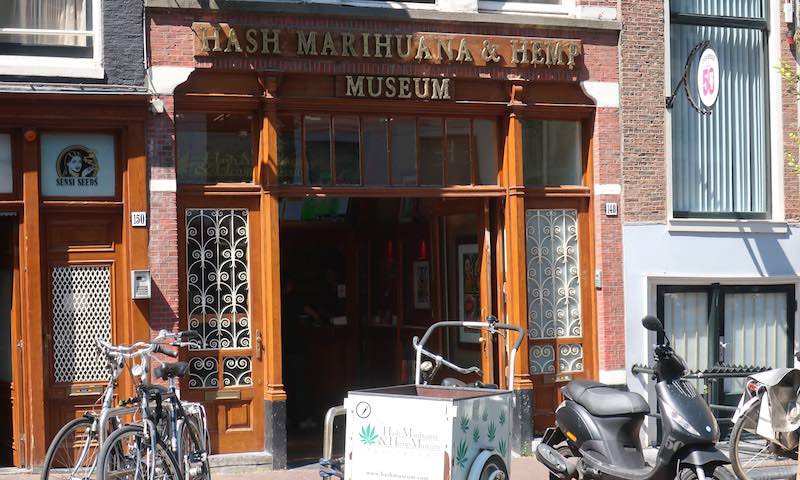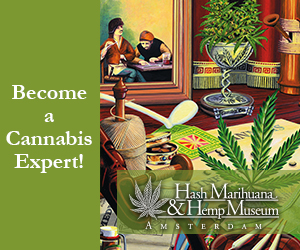Hash Museum Amsterdam
Posted on: Februar 20, 2025

Hash Marihuana and Hemp Museum Review
YES, I WANT TICKETS NOW >If you’re planning a trip to Amsterdam and have an interest in cannabis and hemp, you’re in luck – the city is home to Hash Marihuana and Hemp Museum, one of the world’s most famous cannabis museums.
This museum offers visitors a unique glimpse into the history, culture, and science behind these plants, and is a must-visit destination for anyone who wants to learn more about the cannabis industry.
In this article, we’ll provide you with the ultimate guide to the Hash Marihuana and Hemp Museum, as well as answer some of the most common questions that new visitors have about cannabis and hemp in the city. So grab your passport and get ready to explore the world of cannabis in Amsterdam.
TICKETS BUCHEN >
Introduction to the Amsterdam Hash Marihuana and Hemp Museum
In our opinion, the Amsterdam Hash Marihuana and Hemp Museum is a unique and informative attraction located in the heart of Amsterdam’s vibrant city center. Established in 1985, the museum is one of the oldest and most comprehensive cannabis museums in the world, with exhibits covering the history, science, and culture of cannabis use and cultivation. Visitors can expect to see a wide range of displays and artifacts related to the plant, including ancient smoking devices, artwork inspired by cannabis, and even a replica of a traditional Moroccan hashish den.
The museum is conveniently located on the Oudezijds Achterburgwal, just a short walk from Amsterdam’s central train station, making it easily accessible to visitors from around the world. The museum is open daily from 10 am to 10 pm, with last entry at 9 pm, and admission prices are affordable, making it an excellent option for travelers on a budget.
A visit to this amazing museum opens your mind to all the possibilities that cannabis has to offer. This unique attraction gives a good global historical perspective on the appreciation of cannabis, political activism and the medical background of marijuana.

What Is Hash?
Hash is a type of cannabis that is made by separating the trichomes – the resin-containing glands – from the rest of the plant material. Trichomes are rich in cannabinoids, which are the active compounds in cannabis.
Hash typically contains a higher concentration of cannabinoids than regular cannabis, making it more potent. There are many different ways to make hash, but all methods involve separating the trichomes from the plant material and collecting them into a concentrated form. Hash can be smoked, vaporized, or used to make edibles. It is also sometimes used to make topical products such as lotions and oils.
What is Hemp?
Hemp is a variety of the Cannabis sativa plant species that is grown specifically for the industrial uses of its derived products. It is one of the fastest-growing plants and was one of the first plants to be spun into usable fiber 10,000 years ago.
It can be refined into a variety of commercial items, including paper, textiles, clothing, biodegradable plastics, paint, insulation, biofuel, food, and animal feed.
Despite its widespread uses, hemp has been largely associated with its cousin – marijuana – and has been illegal in the United States since the 1937 Marijuana Tax Act placed strict regulations on hemp cultivation. In 2018, the US Farm Bill finally removed hemp from the Controlled Substances Act and hemp farmers across the country are now able to legally grow and sell their crop. Hemp sales are expected to exceed $1 billion by 2022.
How to identify hemp plant?
There are a few key characteristics that can help you identify a hemp plant. First, hemp leaves are relatively long and slender, with pointed tips. They are arranged alternately on the stem, and they have serrated edges. Second, hemp plants have thin, fibrous stems that are hollow in the center. Third, hemp flowers are small and greenish in color, and they grow in clusters. Finally, hemp fruits are dry and slippery, with hard shells that contain two Seeds each. If you see a plant that exhibits all of these characteristics, there’s a good chance it’s a hemp plant.
Is hemp psychoactive?
Psychoactive refers to a drug that produces changes in perceptions, mood, and consciousness. Hemp, however, does not produce these changes. psychoactive drugs work by changing the levels of neurotransmitters in the brain. Neurotransmitters are chemicals that relay messages between neurons. Hemp does not affect neurotransmitter levels and therefore does not produce psychoactive effects. psychoactive drugs also bind to receptor sites in the brain. Receptors are proteins that receive and transmit chemical signals. Hemp does not bind to receptor sites and therefore does not produce psychoactive effects. psychoactive drugs can have short-term or long-term effects. Short-term effects include changes in perception, mood, and cognition. Long-term effects can include addiction and tolerance. Hemp does not produce psychoactive effects and therefore does not have short-term or long-term psychoactive effects.
How is hemp different than weed?
While hemp and weed are both forms of the cannabis plant, there are a few key differences between the two. Most notably, hemp contains much lower levels of THC than weed, meaning that it does not produce the psychoactive effects that are associated with marijuana use. Instead, hemp is typically used for industrial purposes, such as making rope and paper. In addition, hemp plants tend to be taller and thinner than weed plants, with long, slender leaves. Hemp is also typically grown outdoors, while weed is typically grown indoors. Finally, hemp plants have a much shorter flowering cycle than weed plants, meaning that they can be harvested more frequently. Taken together, these differences make hemp and weed two very different types of plants.
Location Of Museum
It is located on the “Oudezijds Achterburgwal” in the Red Light District and actually consists of two separate buildings: the museum and the gallery. Two experiences for the prices of one! 18+ visitors can also experience the vapours from the five marijuana plants that are cultivated inside the museum, in a special vaporising room.

Vintage cannabis promotional material.
Audio Tours
Take the audio tour with you to get the most information about all the different exhibit pieces. At the entrance you can get a small speaker box which allows you to scan barcodes to get an added audio explanation.
The audio tour is available in Spanish, Italian German, English, Dutch, Portuguese and Russian and comes kostenlos with your entrance ticket.
TICKETS BUCHEN >

Weed culture on display in Amsterdam’s Hash Marihuana and Hemp Museum.
The Hash Museum Building
Hemp is one of the oldest produce known to mankind. The museum area delves into the different use cases of the crop: recreational, medicinal, as textiles and oil. These days, the hemp plant is seen as a great alternative for cotton. The cultivation of cotton requires a lot of water and harmful pesticides. Its harvest is also very labor intensive. Contrast those characteristics with hemp: a strong, undemanding, versatile crop. The harvesting of hemp could easily be mechanised.
History: Cannabis in Amsterdam in the 1970’s
The hash museum also delves into the ‘legalization’ of cannabis in the Netherlands in the 1970’s which led to the now world famous coffeeshops. It also explores the US led global war on drugs. Great artwork is on display including classic propaganda posters. You can also find many great quotes from (famous) people from the past, and the present, about cannabis. You might be surprised about who are among them!
Ben Dronkers Sensi Seeds

Ben Dronkers (left) with Richard Branson.
The founder of the Hash Marihuana and Hemp Museum is Ben Dronkers. He’s also the founder & CEO of Sensi Seeds – a Dutch company and the largest cannabis seed producer in the world. Mister Dronkers was one of the first cannabis pioneers in the Netherlands and helped from the start – late 1960’s – with the supply of cannabis related products in Amsterdam.
Quote of Ben Dronkers:
"There is no plant that is so versatile, has such a wonderful history and so much potential for the future. Our aim is to show just how special this plant is and how varied its applications are.”
We interviewed the CEO of the Hash Marihuana and Hemp Museum. Learn more about cannabis from Ben Dronkers.
READ INTERVIEW >

Our tour guide enjoys the Part of the Women Of Weed exhibition during his visit to the museum
The Hash Museum Amsterdam
The Gallery part of the Hash Museum offers na unique exhibit of selected artifacts that are really worth the visit. This place is not just for those who are interested in the traditions of recreational and medical use of cannabis. It also caters to the people who are interested in the history and social questions surrounding the use of hemp.
This part of the museum also hosts a varying exhibit. Currently it highlights some amazing women who’ve shaped the current cannabis world. The excebition features “Whoopi and Maya”, a company co-founded by famous American actress Whoopi Goldberg.
Also featured is Mila Jansen, aka ‘the queen of hash’ who herself established the precursor to Amsterdam’s coffeeshops. An exceptional photo series portrays female cannabis users: an ode to the diversity of Amsterdam’s cannabis culture.
Hash Marihuana and Hemp Museum Amsterdam Price
The admission price for the gallery and the museum combined is € 9,- euro per person. For children up to the age of 13 the entrance is free, if they are accompanied by an adult. If you buy your ticket via the museum’s website you get a 5% discount.
For groups of 10 persons or more there is a 20% discount option if you make the booking in a single reservation. Payment at the door can be done via cash, credit card or debit card.
Inside The Hash Marihuana and Hemp Museum & Gallery
Reviews: What tourists say?
⭐️⭐️⭐️⭐️⭐️
Shereena Lootah: Very informative and detailed, even though the space is small, there’s a lot to see and listen to over the audio which has several languages. It’s also one ticket for 2 museums so don’t forget about the second museum which includes a lot of the industrial uses for hemp. We also got free samples of hemp seed tea from the store Hempstory between the two museums. Source: Google review.
⭐️⭐️⭐️⭐️
Yas: A nice museum with a lot of interesting information about the marihuana and hemp, the history of its use, and the political developments. You get a little speaker thing as part of the ticket price where you can choose a language and get information about different things relating to weed throughout the museum. A lot of interesting information relating to different aspects. At times, the spoken information was a bit too long and I lost focus, but stopping the audio was always an option. Overall a great museum experience, would definitely recommend going here if you’re in Amsterdam. Source: Google review.
Hash Museum Amsterdam Tripadvisor Reviews

Three TripAdvisor reviews from people who’ve visited the museum.
Hash Museum Amsterdam Tickets
Visiting the Hash Marihuana and Hemp Museum is a must do when you’re interesting in cannabis and the liberal Dutch culture. The normal entrance fee is 9 euro, but if you buy you ticket online, then it cost 8.50 euro:
BOOK HERE >
How much is a gram of weed in Amsterdam?
In Amsterdam, weed is sold by the gram. A single gram of weed costs approximately 10 euros. This price can vary depending on the quality of the weed and the supplier. The average cost of weed in Amsterdam is about 8 euros per gram.
Have you already been to the Hash Marihuana and Hemp Museum? Let the world know how it was by sharing your experience in the comment section below.
How long does weed stay good?
When it comes to preservability, marijuana’s shelf life is pretty similar to other herbs. If properly stored, dried weed can last anywhere from 6 to 12 months. The biggest enemies of pot’s longevity are light, air and humidity – all of which can cause your weed to degrade and lose THC content.
To keep your weed lasting as long as possible, store it in a dark, airtight container in a cool, dry place. You can also extend its shelf life by keeping it in the freezer, although this may impact the taste and smell of your cannabis. All things considered, if you take proper care of your weed, you can enjoy it for many months to come!
For how long would marihuana show on drug test?
The amount of time that marihuana will show up on a drug test depends on several factors, including how often the drug is used and the type of drug test being administered.
Generally, marihuana can be detected in urine for up to 30 days after last use. However, for heavy users, the drug may be detectable for up to 90 days. Blood and hair tests are less common, but can also be used to detect marihuana use.
Blood tests can detect the drug for up to 24 hours after last use, while hair tests can detect drug use for up to 90 days. This means that if you are taking a drug test, it is important to know what type of test it is and how long ago you last used marihuana. Otherwise, you may end up with a false positive.
LESEN SIE AUCH:
Karte des Amsterdamer Rotlichtviertels





